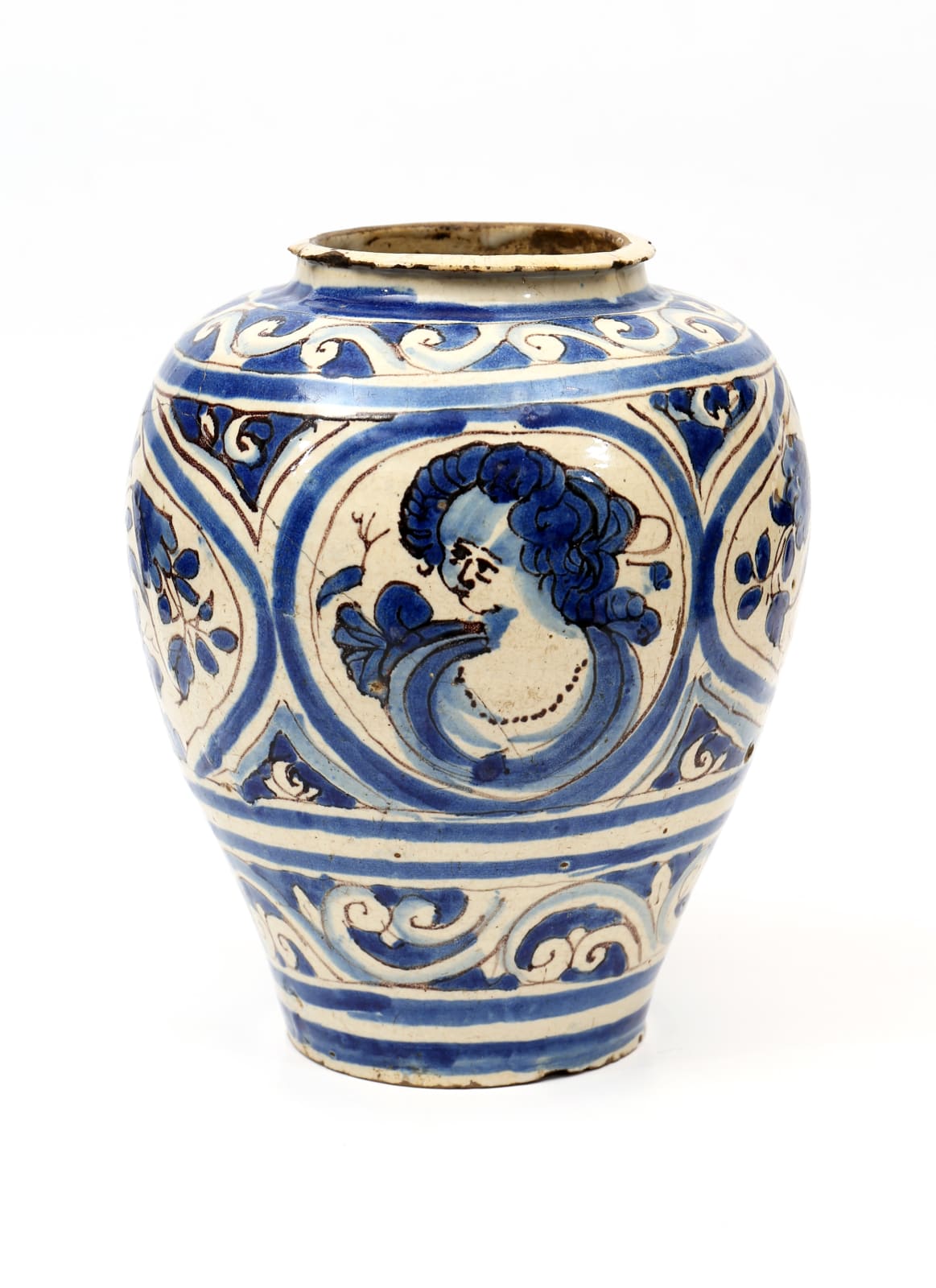Pote, 1660-1680
faiança portuguesa / portuguese faience
Alt. / H.: 27,0 cm
C461
Elegant 17th century Portuguese faience pot, of rounded ovoid
body shape and short neck, decorated in cobalt-blue and manganese-purple.
The body is sectioned into two circular roundels with female
busts wearing contemporary headdresses, known as ‘Bellas’ and
influenced by Italian Majolica, alternating with lozenge of flowers.
On the shoulder a band of white scrolls on a blue background
and, close to the base, a typically baroque ring of scrolls outlined
in manganese-purple and encased by cobalt blue bands.
As previously mentioned, (cf.: C753, no. 82), the ‘Bellas’
was inspired by the 16th century Italian Majolica, where the most
beautiful women in the city were portrayed and identified as ‘Belle
Donne’, the ones that had the most admirers1.
Elegant 17th century Portuguese faience pot, of rounded ovoid body shape and short neck, decorated in cobalt-blue and manganese-purple. The body is sectioned into two circular roundels with female busts wearing contemporary headdresses, known as ‘Bellas’ and influenced by Italian Majolica, alternating with lozenge of flowers. On the shoulder a band of white scrolls on a blue background and, close to the base, a typically baroque ring of scrolls outlined in manganese-purple and encased by cobalt blue bands. As previously mentioned, (cf.: C753, no. 82), the ‘Bellas’ was inspired by the 16th century Italian Majolica, where the most beautiful women in the city were portrayed and identified as ‘Belle Donne’, the ones that had the most admirers1.
1 A Colecção de Faiança do Museu de Artes Decorativas de Viana do Castelo, 2015, p. 21.
Elegant 17th century Portuguese faience pot, of rounded ovoid body shape and short neck, decorated in cobalt-blue and manganese-purple. The body is sectioned into two circular roundels with female busts wearing contemporary headdresses, known as ‘Bellas’ and influenced by Italian Majolica, alternating with lozenge of flowers. On the shoulder a band of white scrolls on a blue background and, close to the base, a typically baroque ring of scrolls outlined in manganese-purple and encased by cobalt blue bands. As previously mentioned, (cf.: C753, no. 82), the ‘Bellas’ was inspired by the 16th century Italian Majolica, where the most beautiful women in the city were portrayed and identified as ‘Belle Donne’, the ones that had the most admirers1.
1 A Colecção de Faiança do Museu de Artes Decorativas de Viana do Castelo, 2015, p. 21.
Provenance
C.P., LisboaExposições
Un Siècle em BLanc et Bleu, Galerie Mendes, Paris, 2016 (cat. p. 158-159)Literature
ROQUE, Mário, Lisboa na Origem da Chinoiserie, Lisboa: São Roque, 2018 (pp. 194-195);SANTOS, Reynaldo dos, Faiança Portuguesa, Séculos XVI e XVII, Lisboa: Livraria Galaica (p. 120)
Receba as novidades!
* campos obrigatórios
Processaremos os seus dados pessoais que forneceu de acordo com nossa política de privacidade (disponível mediante solicitação). Pode cancelar a sua assinatura ou alterar as suas preferências a qualquer momento clicando no link nos nossos emails.
